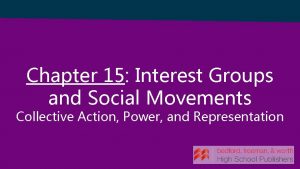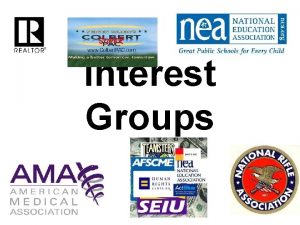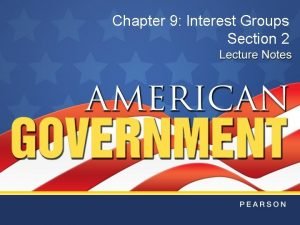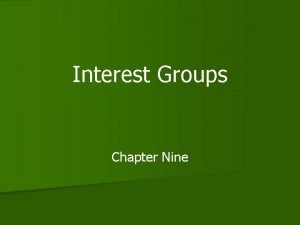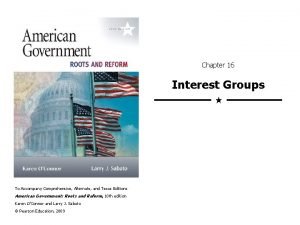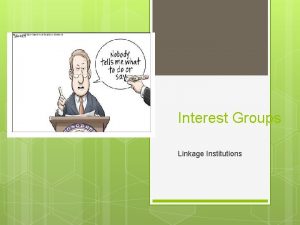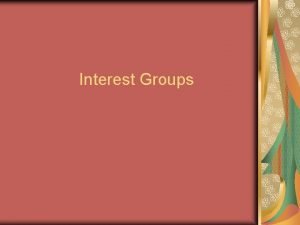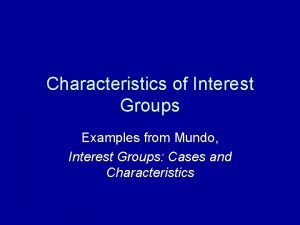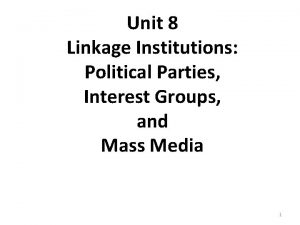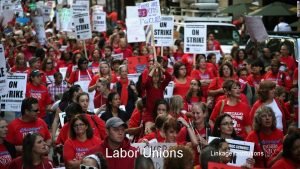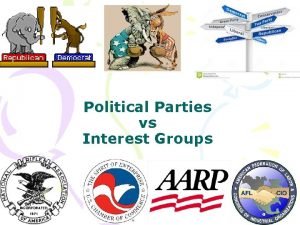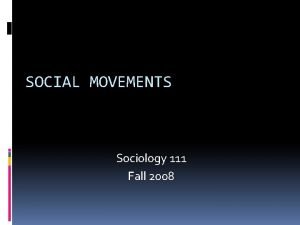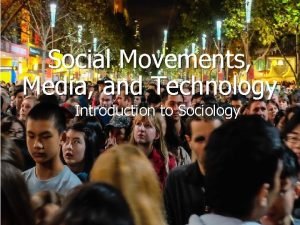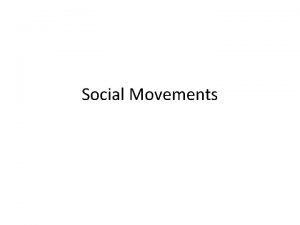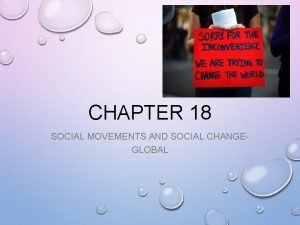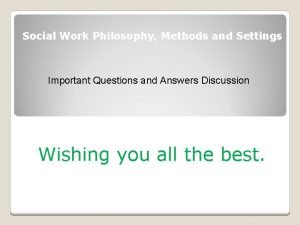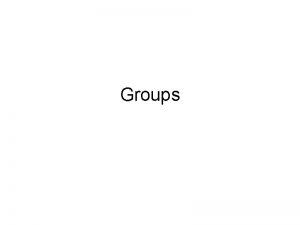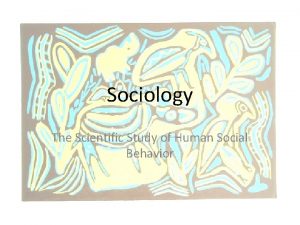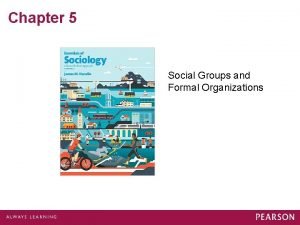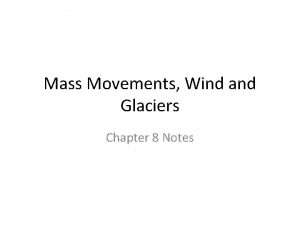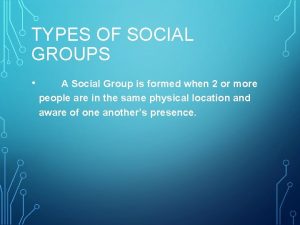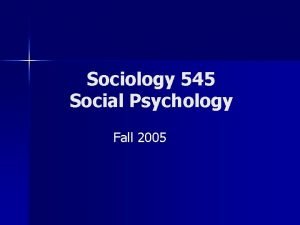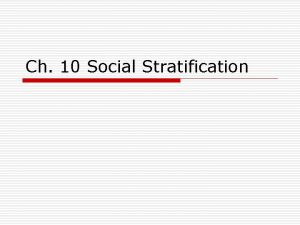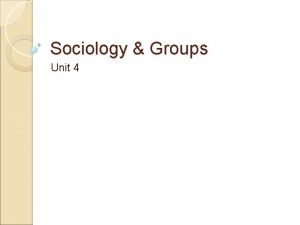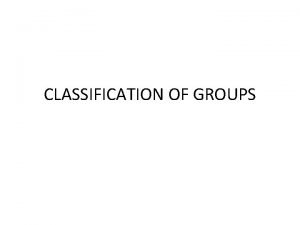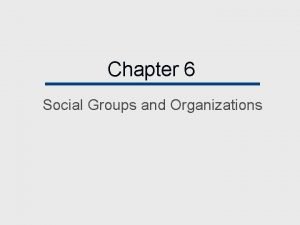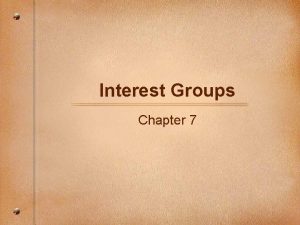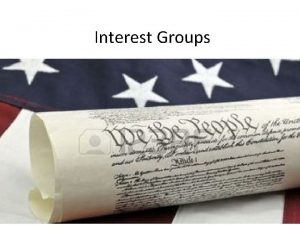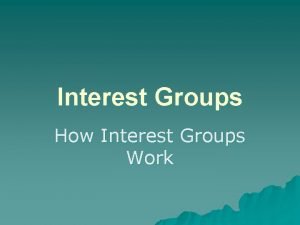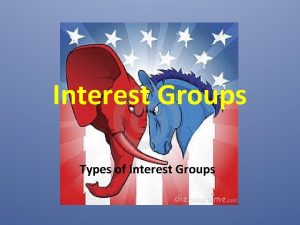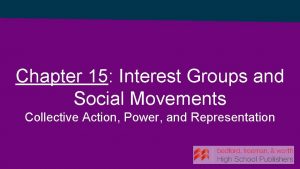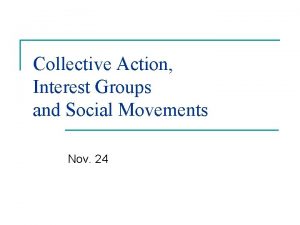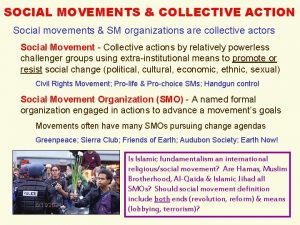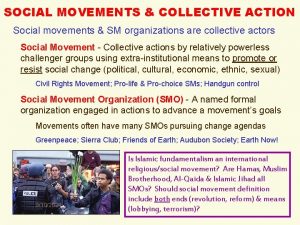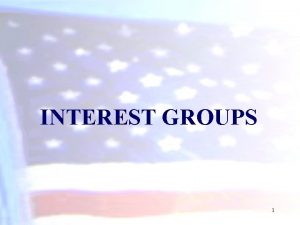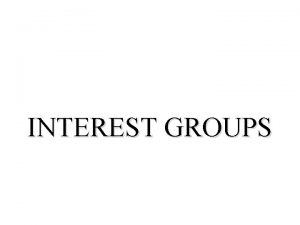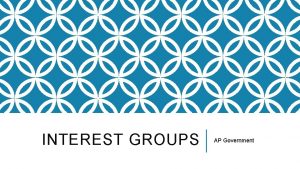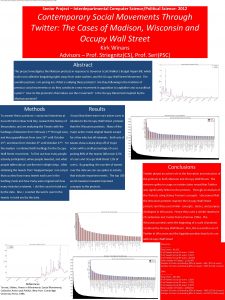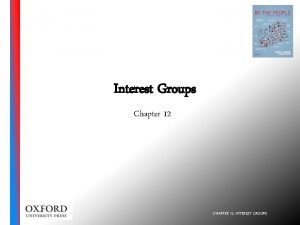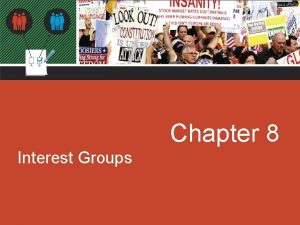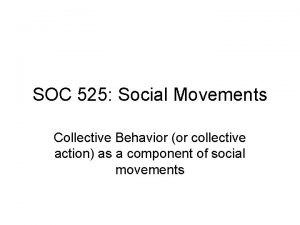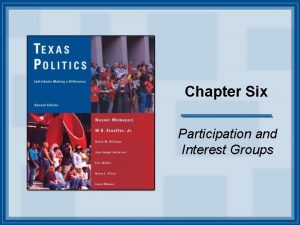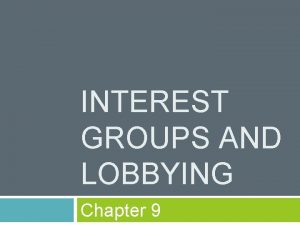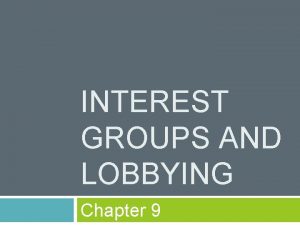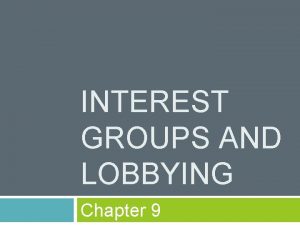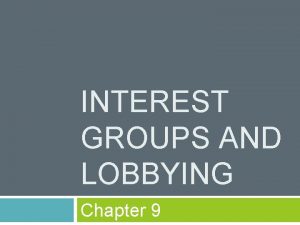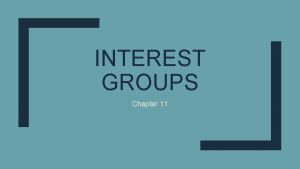Chapter 15 Interest Groups and Social Movements Collective






































- Slides: 38

Chapter 15: Interest Groups and Social Movements Collective Action, Power, and Representation

Acting Collectively

Ch. 15 Learning Targets • 15. 1 Describe the factors that impact whether or not interest groups will be effective in reaching their policy objectives. • 15. 2 Describe the tactics used by interest groups to achieve their goals and how they interact with bureaucratic agencies and members of Congress through iron triangles and issue networks. • 15. 3 Explain how social movements have an impact on

Section 15. 1 Introduction • Interest groups – voluntary associations of people who come together with the goal of getting the policies that they favor enacted • Social movements – diffuse groups that educate the public and put pressure on policymakers in an effort to bring about societal change

Section 15. 1 Net Neutrality • Under FCC rules, internet service providers were prohibited from “speeding up, slowing down, or blocking” content • New rules enacted during the Trump administration • What interest groups were involved in this issue and what were they attempting to accomplish?



Section 15. 1 Interest Groups in American Representative Democracy • Exercising your right to form groups is, in essence, forming a faction – James Madison, Federalist No. 10 • Factions are inevitable in a representative democracy and represent liberty • Lesson the dangers of faction by allowing them to compete • Interest groups compete over conflicting policy desires


Section 15. 1 Theories of Interest Group Formation • Three main theories explain the impact of groups on the political process – all seek to control the policy agenda: – Theory of participatory democracy – the belief that citizens impact policymaking through their involvement in civil society • Groups outside the government that advocate for policy – Pluralist theory – political power is distributed among many competing groups, which means that no one group can grow too powerful – Elite theory – at theory that the wealthy elite class has a disproportionate amount of economic and political power


Section 15. 1 Challenges Facing Interest Groups • Collective action – political action that occurs when individuals contribute their energy, time, or money to a larger group goal – Depends on size, wealth, and political power of a group • Collective good (public good) – a public benefit that individuals can enjoy or profit from even if they do not help achieve it – Individuals may enjoy collective goods and benefit from the actions of an interest group without contributing – free rider problem • Selective benefits – benefits available only to those who join the group


Section 15. 1 Review “Think” • Was James Madison correct in his assumption that the Constitution would reduce the dangers of faction? • What are the advantages of joining an interest group instead of just being a free rider?

Section 15. 1 Review Question: Free Response

Interest Group Tactics

Ch. 15 Learning Targets • 15. 1 Describe the factors that impact whether or not interest groups will be effective in reaching their policy objectives. • 15. 2 Describe the tactics used by interest groups to achieve their goals and how they interact with bureaucratic agencies and members of Congress through iron triangles and issue networks.

Section 15. 2 Interest Group Tactics • Broad categories of groups • Economic – advocate on behalf of the financial interests of their members • Public – act on behalf of the collective interests of a broad group of individuals • Single-issue – associations focusing on one specific area of public policy, often a moral issue about which they are unwilling to compromise • Government – organizations acting on behalf of local, state, or foreign governments

Section 15. 2 Lobbying by Interest Groups • Interacting with government officials in order to advance a group’s public policy goals – Done to all branches • Legislative – influence legislation • Executive – how laws are implemented • Judicial – how laws are interpreted • Lobbyists provide useful knowledge and access to those in government • Revolving door – the movement of individuals between positions in government and lobbying positions • Lobbyists have greater access to policymakers than average


Section 15. 2 Influencing Legislation • Congress is a target for lobbyists • Strategies: – – Contact members or their staff Prepare research reports and briefs to bring more attention to issue Draft bills and lobby to have them introduced Provide useful and timely information


Section 15. 2 Lobbying Government Agencies • When establishing rules and procedures, bureaucratic agencies generate data and hire experts • Aide in the creation of regulation, just like policy

Section 15. 2 Influencing the Judiciary • File lawsuits – Brown v. Board of Education – NAACP attempted to end legal segregation • When not party to a case, can file amicus curiae briefs – attempt to persuade the Court to agree with the arguments set forth in the brief • Influence judicial appointments

Section 15. 2 Iron Triangles and Issue Networks • Iron triangle – the coordinated and mutually beneficial activities of the bureaucracy, Congress, and interest groups to achieve shared policy goals • Issue network – the webs of influence between interest groups, policymakers, and policy advocates

Section 15. 2 Interest Groups, Money and Campaigns • Can form political action committees (PACs) to donate money directly to candidates – Limited • Can form Super PACs to run its own ads independent from a candidate or campaign – Unlimited • Mobilize voters – GOTV, endorsements, scorecards

Section 15. 2 Mobilizing Members through Grassroots Lobbying and Political Protest • Grassroots lobbying – mobilizing interest group members to pressure their representatives by contacting them directly through phone calls, email, and social media • Protests may gain the attention of the media; inform public • Spreads the word quickly about an issue


Section 15. 2 Review “Think” • How do the tactics used by wealthy interest groups differ from the tactics used by groups with fewer monetary resources? • What are the advantages and disadvantages of the revolving door in the policymaking process?

Section 15. 2 Review Question: Free Response

Social Movements

Ch. 15 Learning Targets • 15. 1 Describe the factors that impact whether or not interest groups will be effective in reaching their policy objectives. • 15. 2 Describe the tactics used by interest groups to achieve their goals and how they interact with bureaucratic agencies and members of Congress through iron triangles and issue networks. • 15. 3 Explain how social movements have an impact on

Section 15. 3 Choices of Effective Tactics • Protest – a public demonstration designed to call attention to the need for change – Often used by social movements • Civil disobedience – intentionally breaking a law to call attention to an injustice – Effective tool used during civil rights movement

Section 15. 3 Successes and Failures of Social Movements • Depends upon the impact that protest has on the electoral system • Elected officials either accommodate the demands of protestors or decide to ignore • Occupy Wall Street struggled as a movement – Lacked clear message – Lost media coverage • #Me. Too Movement – Viral campaign spreading message of sexual harassment successful at holding high profile individuals accountable for actions via



Section 15. 3 Review “Think” • What are the advantages and disadvantages of forming a social movement, rather than an interest group? • Why are some social movements successful in achieving their policy objectives while other social movements fail?

Section 15. 3 Review Question: Free Response
 Interest groups vs social movements
Interest groups vs social movements It is also called axial movements
It is also called axial movements Chapter 9 section 3 interest groups at work
Chapter 9 section 3 interest groups at work Chapter 9 section 2 types of interest groups
Chapter 9 section 2 types of interest groups How are ethnic groups and religious groups related
How are ethnic groups and religious groups related What is real interest rate and nominal interest rate
What is real interest rate and nominal interest rate 0 965
0 965 Why are interest groups important
Why are interest groups important The nature of interest groups
The nature of interest groups A virtue of interest groups is that
A virtue of interest groups is that Interest groups linkage institutions
Interest groups linkage institutions Proliferation of interest groups
Proliferation of interest groups State two characteristics of interest groups
State two characteristics of interest groups Linkage institutions definition
Linkage institutions definition Linkage institutions
Linkage institutions Federalist 10 interest groups
Federalist 10 interest groups What are interest groups
What are interest groups Fundamental goal of interest groups
Fundamental goal of interest groups Effective rate of interest
Effective rate of interest Social movement examples
Social movement examples What is a social movement sociology
What is a social movement sociology Social movement examples
Social movement examples Characteristics of social movements
Characteristics of social movements Social movement
Social movement Primary and secondary groups
Primary and secondary groups Scientific study of social behavior and human groups
Scientific study of social behavior and human groups Social groups and formal organizations
Social groups and formal organizations Examples of mass movement
Examples of mass movement Social thinking adalah
Social thinking adalah Social thinking social influence social relations
Social thinking social influence social relations What is social group
What is social group Different types of social groups
Different types of social groups Voluntary group and involuntary group examples
Voluntary group and involuntary group examples Different types of social group
Different types of social group The hierarchical arrangement of large social groups
The hierarchical arrangement of large social groups Sociology social groups
Sociology social groups Example of remedial model
Example of remedial model Outline the characteristics of primary groups
Outline the characteristics of primary groups Characteristics of social groups
Characteristics of social groups
